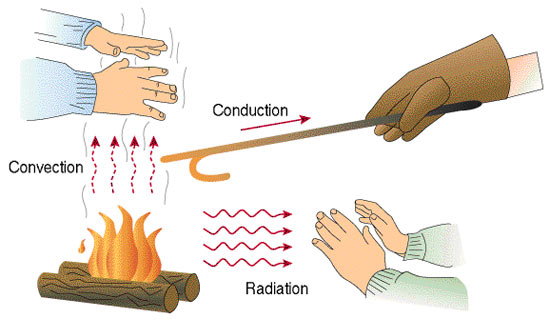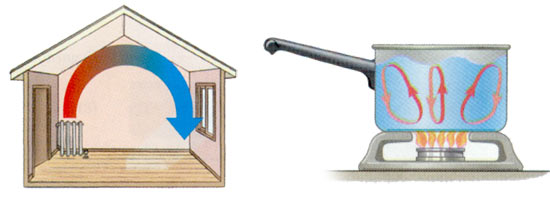Principles of thermal insulation: heat transfer via conduction, convection and radiation
| 30 April 2007 - Comments (11) | Construction |
 Everybody will agree that good thermal insulation of one house is key for comfort and for saving on the heating bill. Yet, there are many concepts behind those two words of thermal insulation.
In this first installment, we look at the physics of thermal insulation. In the second installment, we will look at the parameters used to measure and compare the quality of thermal insulation solutions.
Everybody will agree that good thermal insulation of one house is key for comfort and for saving on the heating bill. Yet, there are many concepts behind those two words of thermal insulation.
In this first installment, we look at the physics of thermal insulation. In the second installment, we will look at the parameters used to measure and compare the quality of thermal insulation solutions.
Heat transfer
The goal of thermal insulation is to maintain a constant and comfortable temperature in one house by preventing heat transfer between indoor and outdoor climate. In cold months, thermal insulation will prevent the indoor heat to escape outdoor. In hot months, it will slow down the entrance of outside heat in the house.
Thermal insulation is therefore designed to control the different component of heat transmittance:
- Conduction through building fabric
- Convection via air movement
- Thermal radiation

The 3 means of heat transmission: conduction, convection and radiation (source Williams College)
Heat conduction
Heat conduction is a very intuitive concept: it represents the spontaneous transfer of heat through matter, in order to even out temperature differences. This explains why a metal bench or chair "feels" cold, while a wooden one "feels" warm. Metal is a very good heat conductor and dissipate body heat through its mass. Wood on the contrary is a poor heat conductor. For the same reason, a metal spoon in boiling water quickly becomes hot, while a wooden one stays cool at the other extremity.
Materials used for thermal insulation must have a very small heat conductivity to be efficient.
Heat convection
Convection represents the transfer of heat by circulation or movement of the hot particles to cooler areas. This is another intuitive concept as we know that hot air or hot water rises. Air or water surrounding a heat source receives heat, becomes less dense and rises. The surrounding, cooler fluid moves to replace it. This cooler fluid is then heated and the process continues, forming a convection current.

Heat convection current triggered by a radiator and in boiling water (source Robert Thews, University of Arizona)
Applied to the thermal insulation of one house, it means that the house must be airtight. This is necessary to prevent hot air from escaping outside and being replaced by cold air from outside. Airtightness is not easy to achieve in construction. And because hot air rises, thermal insulation of the roof or ceiling is extremely important to prevent heat loss.
Thermal radiation
Thermal radiation represents the transfer of heat by electromagnetic radiation. The sun, or an electric radiator, are perfect examples of radiating objects producing heat. Bright, shiny materials, such as radiant barriers, reflect radiation while dull, black materials absorb it. Good insulators are not necessarily good radiant barriers, and vice versa. An example of radiant barrier is the bright material you can put on the windshield of a car to protect it from overheating in summer.
Thermal radiation of the sun is of particular importance when it comes to thermal insulation. During the cold months, that energy is most welcome and houses should be designed to let it in. In summer, on the contrary, thermal radiation of the sun should be kept away from the house indoor in order to maintain a cool interior.
Roof and windows are the most concerned about thermal radiation. For the roof, it is possible to place radiant barriers and/or to build a ventilated roof which allow the radiant heat to dissipate via convection.
Regarding windows, it is possible to find reflective glazing, which maximizes light transmission while reflecting solar radiation. Another type of glazing called low E glass (low emissive), has a metallic or oxide coating, which reduces transfer of heat or cold through the glass while still allowing light through. In any case, the most efficient way to avoid radiant heat from windows in summer is to protect them from direct sun exposition. That can be done using overhangs (see figure below), shutters or vegetation.

An overhang, for a south facing window, is working by shading the window during summer, when the sun is high in the sky, while letting the sunlight in, in winter, when the sun is low in the sky. (source IdeesMaison.com)
Conclusion
We presented the main concepts behind thermal insulation. First the concept of heat transfer and then the means of heat transfer via conduction, convection and radiation. The goal of thermal insulation is to resist those heat transfers by using material with low thermal conductivity. In the next installment we will explain what is thermal conductivity and the other concepts around it.







































27/02/2011
john
11
thanks
26/02/2011
Parashuram Gawade
10
Heat transfer
20/01/2011
brahim
9
Re: Principles of thermal insulation: heat transfer via conduction, convection and radiation
17/01/2011
pradeep kumar viet,dadri
8
radiation teaching
13/01/2011
Anonymous
7
Re: Principles of thermal insulation: heat transfer via conduction, convection and radiation
28/12/2010
maliha
6
science
22/02/2010
manuden
5
Thermal radiation principles
16/02/2010
admin
4
Re: Science
16/02/2010
trish
3
science
15/09/2009
samuel akoto
2
thanks for teaching me
04/12/2008
kenyetta
1
thanks...